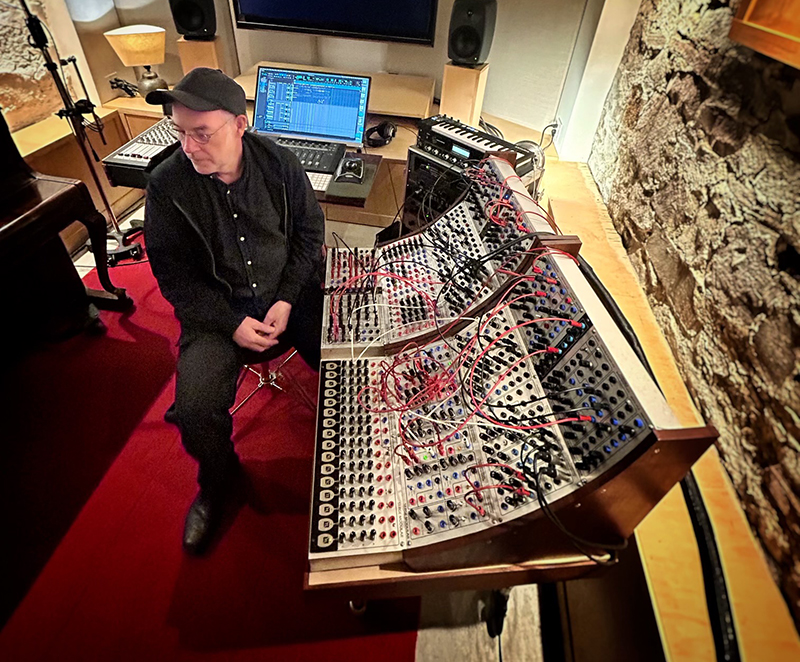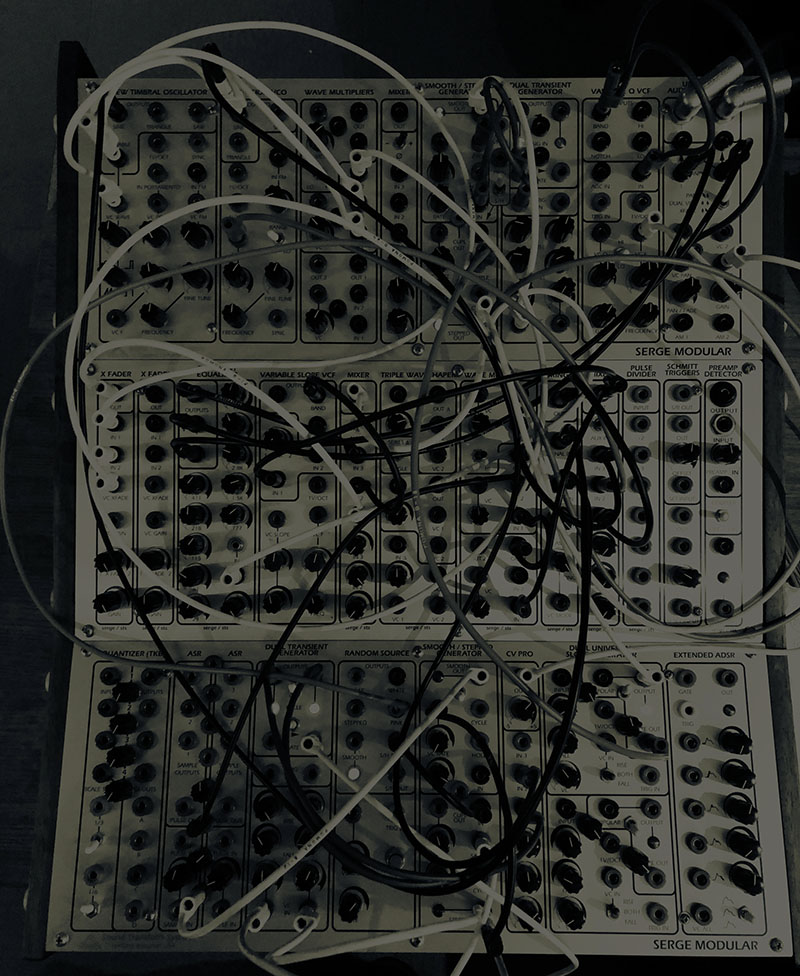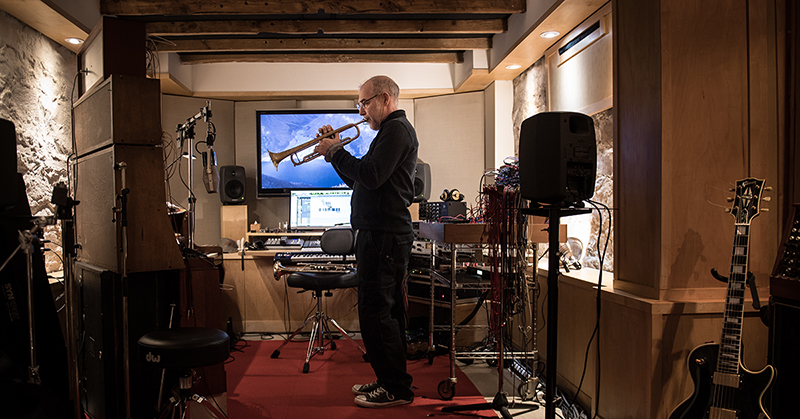
Michael White is a composer/performer, playing trumpet and modular synthesizers who, over the years, has scored feature films, series, documentaries and radio dramas.
As a musician he has been active playing concerts, club shows and as a session player on albums and films since his early 20’s.
As a composer his recent music focuses on sound texture, structure and improvisation using modular synthesizers.
He had already graced us with that wonderful Session :
https://modulisme.info/session/44/
With great pleasure we welcome him back on board. ENJOY !
Would you please describe the system and the compositional process you used to create the music for us?
I used my Serge which was made by the Sound Transform Systems (STS). It is split into two cases, 8 panels in one and 3 panels in the second case. The system is made up of 6 shop panels, 3 m-class and 2 custom panels. Also I used my set of “hale” modules I have in places to augment the Serge.
Compositionally my usual approach of finding a few interesting cells, elements, harmonic, rhythmic, timbral or combinations that I could improvise with was the starting point. I routed these cells to the matrix mixer creating some simple feedback paths. These were parallel loops also routed through the matrix mixer, each would have a resEq, a wave multiplier, phaser or wave shaper inserted. The feedback loops were intentionally simple, one processor per loop, so I would have the ability to send the loops into each other at various indexes making more complex and unstable sounds on the fly while maintaining the ability to return to the stable original cells. The CV streams were being mixed using processors manipulated and routed manually in most cases but I recall using the “ActivePro” (DC crossfader/VCA) a number of times.
Once I had a feel for the feedback network I started recording improvisations. Hour or so I would take a break and listen to what I had recorded, in studio or on a walk. I made a few mental notes or wrote in a notebook on what was interesting and what the form or structure could be. When I returned to the studio and played a few more takes of improvising on the elements I thought I had the potential of a journey or unfolding to it. I made a lot of these, listened to them and tried to decide which could fit together as a group. Once I had a set I edited them a bit to make them more unified. Since I recorded the music live in stems (divided over a number of tracks) I was able to do some gardening and cut out some of the less successful things while maintaining what was on the other track or shortening the whole idea. Kind of like pulling the weeds and cutting back branches that are covering interesting bits. I didn’t re-order or add layers to the performances.
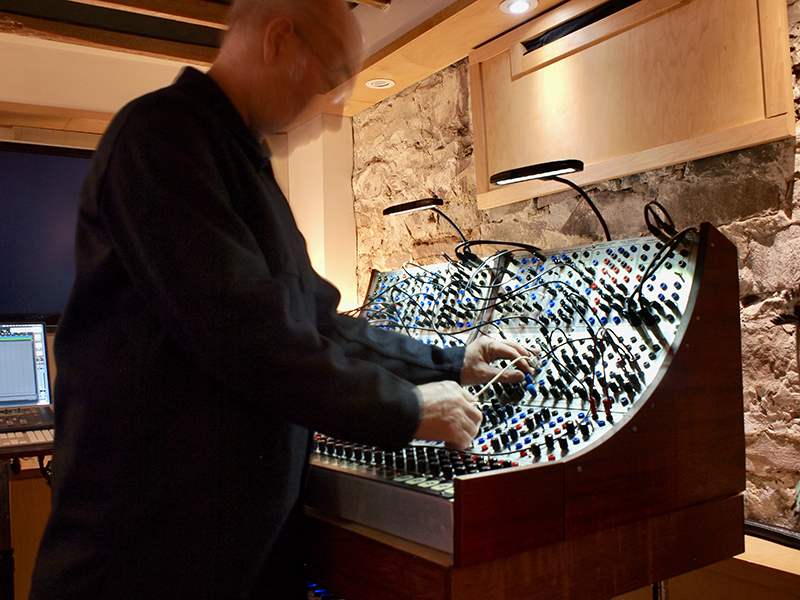
You are mostly composing for films, drawing on modern composing techniques.
What have you been working on lately?
As a composer and modular synth-player I’m self-taught. The techniques I draw on have been absorbed from composers and players I listen to and admire.
As a trumpet player for New Music Concerts Toronto, directed by Robert Aitken, I have been extremely fortunate to meet some of the most influential composers of our time: Cage,Xenakis, Berio, Takemitsu, Tenney, Carter, Reynolds, Birtwistle, Kagel, Riley, Rzewski, Globokar, Manoury and others. These experiences combined with my love of alt rock, punk and improvised music is what informs my style, technique and attitude towards music. Hopefully I deploy these influences in my own way that is identifiable as me.I’m working on some live performance ideas for Serge and video. The idea centres around combining long unsynchronized loops of abstract film, visuals such as clouds, sky, overhead electrical wires etc. with live patching on the Serge, perhaps with other instruments. I know these type of pieces with music and film have been done many times before but I hope to find my own spin on the genre.
Beyond working on this, I’m releasing my own music on Bandcamp and working as a synthesist and session musician on a number of series and movies that are in production now.
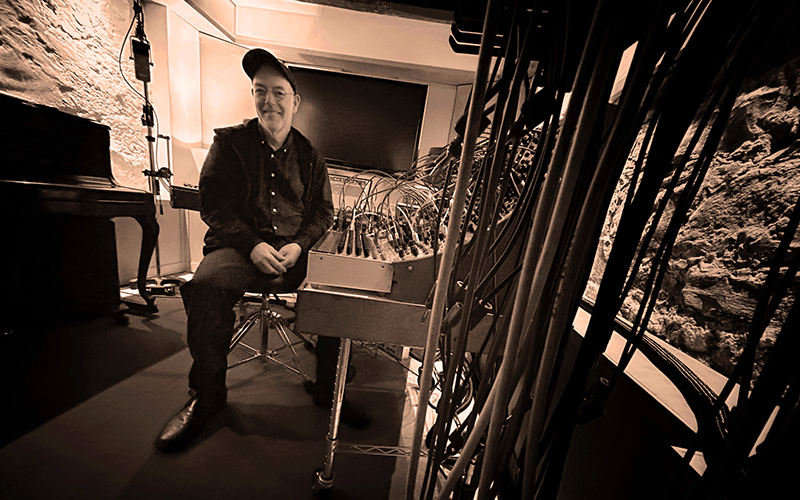
How do you manage to adapt your modular music in synch to images?
Using a modular for scoring films is really natural for me. My interests in film music tend to lean towards the abstract and textural things that modulars excel in. I’m lucky that I don’t really have to adapt or change much when writing for picture or pure music, mainly because the people I work with, want what I do. I use the same patching style and techniques whenever I make music with the Serge. The composers I work with don’t generally need the typical “synth” basses, drones or “tickers” they can get quickly with their own instruments or sample libraries. I come in with experimental modern composing techniques and crazy ideas in the hope to find something different yet still connect to the score concept and tone. Generally it’s too time consuming for the composer to experiment with left-field ideas, so that’s my job, I look for things that fit the picture and score which are unique, that can elevate the score and story. One difference when working to picture in the computer is the default master-clock. To lock with the computer and tempo of a cue I dedicate a track of midi notes with the fastest value I think I might need then use a midi to CV box to turn that midi track into gates for the Serge. I divide this pulse train to create and improvise rhythms in real time and do a lot of manual parameter moves. I also often use asynchronous or polyrhythmic pulses to add tension or modulate the pulse dividers which, for the most part I use Universal Slope Generators (DUSG’s) for this. Some of the “atmospheres” and “clouds” are done without using the sync’d clock. When I’m hired as the composer on a film I usually sketch out the basic cues and arc of the score using the Serge then fill in with other instruments to carry the thematic and harmonic end of the score. Once the themes and structure are set, I do overdubs with the Serge and refine those parts as needed. I have a wonderful group of musicians who are long-time friends I use for this and enjoy the collaboration we get.
Do you still need an interaction with an audience or are you happy with studio work?
I’m always needing situations that have interaction, live or in studio. Playing in front of an audience is the fastest way for me to experience the positive effects.
An audience can test the confidence I have in an idea and how I’m trying to execute. It can show cracks in a concept or that it’s working as well as amplifies my focus and self-critiquing. An audience can be one person or lots of people – doesn’t matter to me. I never take performing for granted and I’m always privileged to get to play in front of any audience.
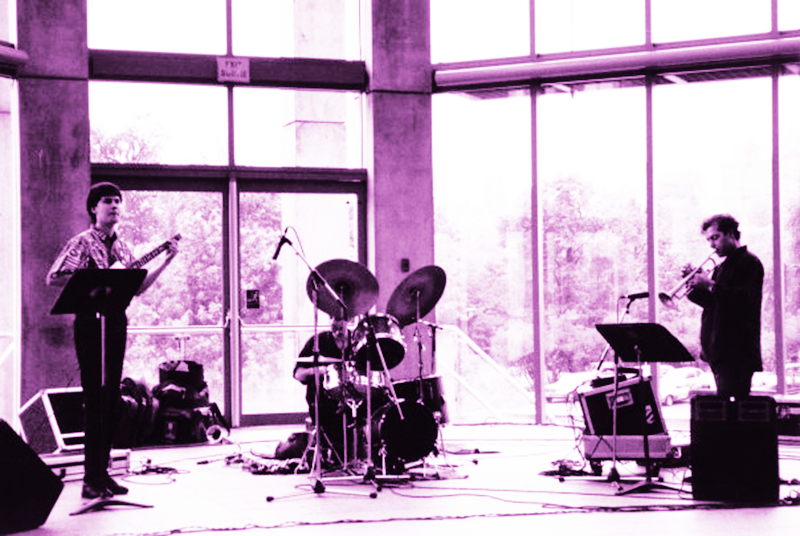
Do you find that you record straight with no overdubbing, or do you end up multi-tracking and editing tracks in post-production?
Most of the music I have made has been constructed with overdubbing and editing. I’ve been working on changing this up lately. This new set of pieces was recorded in real-time one pass with only small edits cutting out things I didn’t think worked. No post re-ordering or layering. I like this editing process as it feels like gardening to me, you come to a wild thing and cut back a few dead branches and all of a sudden something shines through. Playing a piece in one pass is both a challenge for me, because it’s not my usual process, and an attempt to make the pieces more integrated structurally. I’ll never abandon overdubbing because it can give you a lot of possibilities for more complex structure and counterpoint when you can reference a master clock from the computer. One pass performances push me to organize the structure of a piece in a different way, or just let things happen on their own. My goal is to execute on a higher level in the moment whether it’s conscious or unconscious. I like both approaches.
Do you pre-patch your system when playing live, or do you tend to improvise on the spot?
I haven’t been playing live as much as I use to for a few years now but I am preparing and have been experimenting with a couple of different approaches. One that’s working for me is very similar to my studio approach, but with fewer panels, which is to start small and build it up through live patching. I’ve tried having a “set” performance patch pre-patched but when I come back to it, the interesting things I found while making it are not as interesting as when I made it. I need to build it in the moment.
Usually, I unpatch my system completely at the end of the day or when I want to start a new idea. I know some players like to leave patches for days and see where they gravitate, which is cool but at the moment it’s not my style. I may experiment with that in the future. I do have a few go-to starting points but I consciously avoid them if I can. So the answer is I pre-patch a few small cells then live patch from there. It’s very similar to the way I work in the studio.
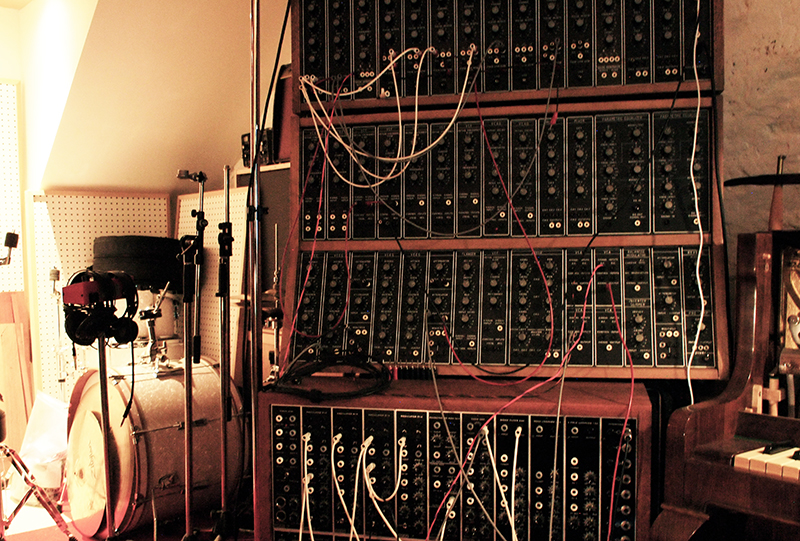
Your first meetings with Modular Synthesis were through the sound of MOOG and then playing Modern instrument. In the end you decided to favour a SERGE system. Would you explain why? How did that happen? Why does the Serge sound superior to your ears?
I found Modular in 2001 and started with Modcan A series. Bruce Duncan the designer and builder just happened to live about a 10-minute walk from my place. So I naturally was in. Modcan is loosely a hybrid Serge with a number of different filters based on Moog and EMS. There is a DTG like module but no DUSG, SSG or dedicated Random module. It’s a beautiful instrument and I used it a lot on film scores but as I became more aware of what Serge is all about, I realized I needed to get one. It’s not only about sound, it was about the ranges of what you can get from super precise to gritty to unstable and the endless ability to re-imagine the instrument every time you play it.
When did you buy your first Serge? What was your first module or system?
2006 I started with a “Ring-Moo” also called “Ani-moo” depending which filter caps are used in the carrier input of the ring modulator, as well I got a TKB on my first order.
A year later I added an m-boat with DUSG, ResEq, comparator, processor and two more filters. This was my system for quite a while.
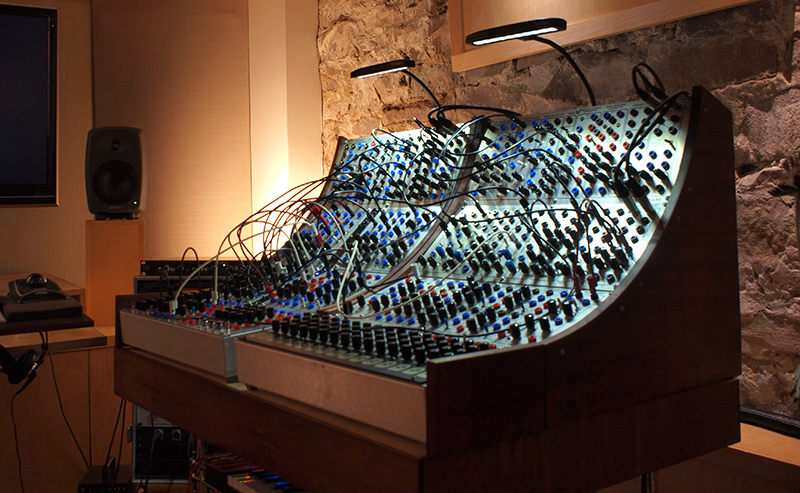
How long did it take for you to become accustomed to the patch-programability developed by Serge Tcherepnin?
When I first got it I understood patch programability as a concept but didn’t appreciate the power. I didn’t know anyone in Toronto with a Serge so I was learning on my own with the Gold book. It wasn’t a bad thing really, it just took a lot of time to recognize the subtleties when you are coming to it cold. Rex Probe of STS did a good job helping me up the learning curve on the phone and email. He was always there for me when I couldn’t figure it out. He taught me the basics of how some of the offsets work and how to open and close windows on a stream of signals with processing. He also instilled the idea of your technique on it being unique to you:
“There is no one way to play the beast Mike”.His idea of building small loci to “steer the ship” in a fluid way also was something I always try to keep in mind when patching. Patching loci so you can have multiple levels of control under the fingers of one hand and try to group control so you can play them without having to move your hand too much. Rex is a guitar and bass player so he approached the loci like hand positions on a stringed instrument. So smart. Eventually I built up enough technique to feel confident enough that I could get something out of it which was interesting on a consistent basis and started using it as my main instrument.
That was maybe 2015 when I expanded my system to 8 panels. I’m still learning something everyday.
What was the effect of that discovery on your compositional process? On your existence?
My compositional process, realizing musical ideas with the Serge is becoming more and more integrated as I use the system, meaning gesture, counterpoint, rhythm and harmony can develop and flow from a structural or tonal network the system is doing. I feel that in the past I used to superimpose my musical ideas onto the instrument which always seemed forced. I’m getting away from that now. Pieces can grow out of simple gestures or an uncontrollable network of modulations feeding back spontaneously, this is the magic of Serge for me.
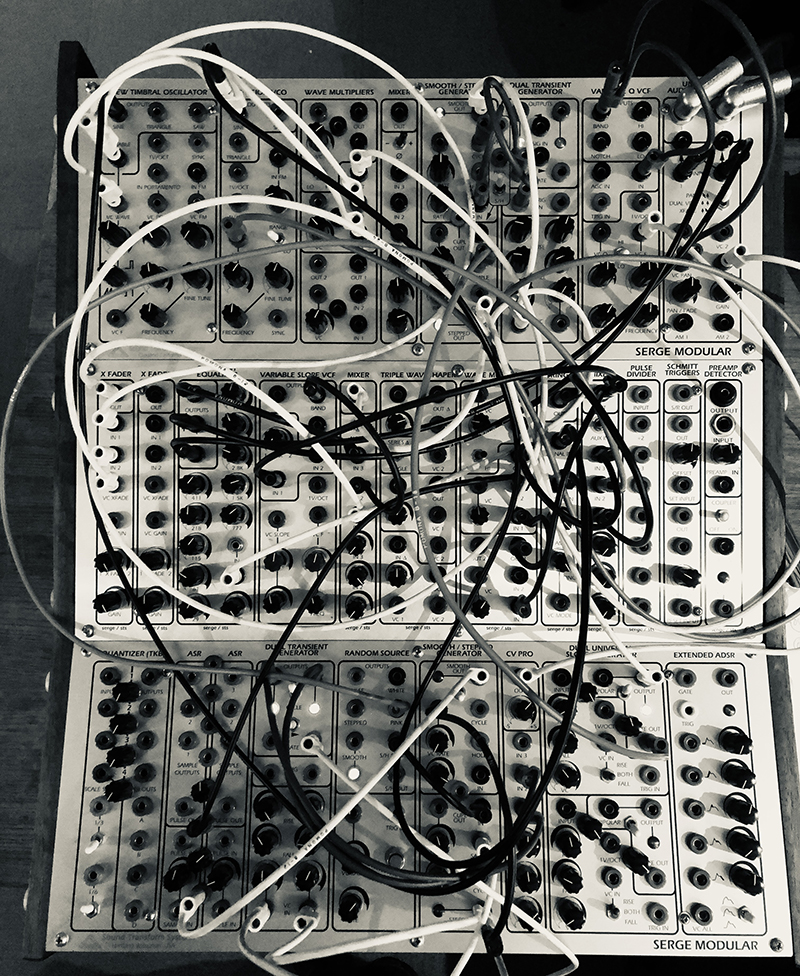
Quite often modularists are in need for more, their hunger for new modules is never satisfied? How has your system-instrumentarium been evolving?
I know you recently grew your system?
My Serge feels complete and I don’t feel the need to expand it.
I am however really excited about getting more of Dakota Melin’s modules.
For those who don’t know Dakota, he is a super musical and brilliant guy, his modules are unique and very well-designed because he understands music and electronics on a very high level. The influence of Serge’s patch programmability is there in his thinking and modules, they all have a few different twists that make them special. His new SEE/SAW is a great example, among the many things it can be patched to do is a CV accurate crossfader with 2 outputs so it can crossfade and at the same time pan as the input signals are alway available at the other output, hence the name SEE/SAW. It has switches for AC or DC coupling as well as phase switches for both inputs. It also can be patched to do a lot of other stuff. The SEE/SAW has become a must have module for me. His company is called hale and has individual modules in the LW format. At the moment I am using his crossfaders, processors, VC Slew, Filter Resonator, sequencer and logic block as a stand-alone system and occasionally as an add-on to my Serge and looking forward to his SYNC VCO.
You play trumpet, you are interested in gesture, physical move to create the music, right? What is your favourite way to achieve such expression? Improvising, taking risks? Combining with other musicians?
Yes, gesture, physical movement and breath are the lifeblood of expression on any instrument. On a modular it’s important for me to consider these elements for the music I try to make. Incorporating various amounts of randomness to timbre, an envelope or feedback network can give more detail to gestures and intensity, it can make the instrument breathe in a very organic way. Playing with the parameters manually in the moment is how I attempt to achieve expression. I like to always have some random CV available in a loci when mixing CVs in a processor.
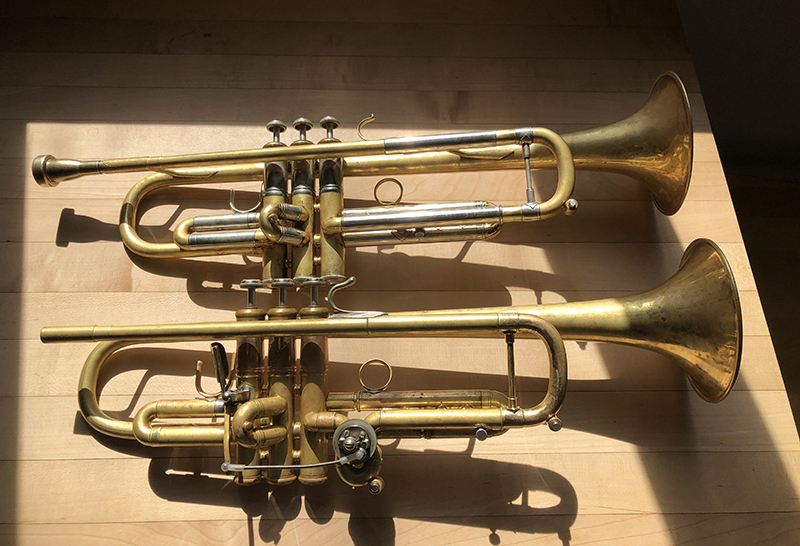
Are you still playing trumpet in groups, improvising? How do you approach live these days?
I haven’t played live for a few years now but really want to get back to it.
Would you say that your choice of instrument can be an integral part of your compositional process?
The music I make is always connected to the instruments I play.
In regards to electronic music I think that an instrument’s architecture and how you decide to approach and play it will influence the music, it’s kind of inevitable. This is similar to a violin or flute where the instrument physically dictates the music it can play. This doesn’t mean you have to accept the standard limitations of an instrument. Performance practice on every instrument is evolving, technique is expanding and musicians are playing previously “unplayable” music on 300 year-old violins. Why not a 50 year-old synthesizer? The Serge’s transparency and wide range of the parameters makes it an exceptionally expressive instrument, that can be approached in the same way as any acoustic instrument. To my thinking this range of expressive control is why the music made with Serge is identifiable not just by the “sound” of the instrument but mainly by how the person plays it.
This is attractive to me.
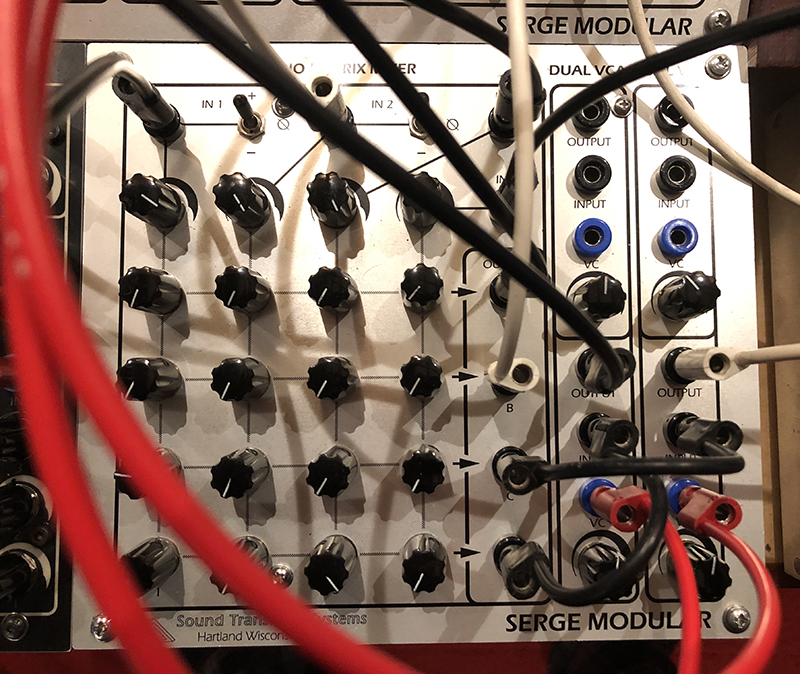
Are you feeling close to some other contemporary Modularists? Which ones?
I feel very close to anyone who takes the time and effort to make music on a modular synthesizer. It’s the dedication to not taking the easy way or the fast way to get somewhere that I admire in general.
The community of modular artists that Modulisme and Modular station are promoting is really inspiring. I now have an expanding group of amazing friends that I can discuss and share my ideas and music with.
It has changed my life and inspired me to keep trying to make new things.
Thank you!
Any advice you could share for those willing to start or develop their “Modulisme” ?
My advice to someone starting out with a modular is to start by approaching it as a solo instrument not a full orchestra. It is easy to get lost if you are trying to do too much all at once. Practice the simple little gestures that are musical, subtle and dynamic and build those techniques into something bigger if that’s what you want.
Be open to improvising and discovering things by accident while at the same time, try to develop an ability to imagine a sound or gesture and create it.
There are no rules!!!
One exercise suggested to me by Rex when I started was to make a sound cell or gesture with a limited number of patch cords. An example of this could be, make a rhythmic patch that maintains a constant pulse but randomly varies the duration of an event onset with 10 patch cords. Or modulate the harmonic spectrum of a complex sound using 2 asynchronous signals with 10 patch cords. Once you get the patch working, try to do the same thing with one less patch cord. See how far you can go taking one away each time you find a new way to do the same type of thing. Simple stuff but it forces you to really think about how each module works in a network.
It can also lead to numerous discoveries by chance that you never imagined and it builds your knowledge of patch programmability. The main thing is to be adventurous find your own way, find a instrument you connect with.
Todd Barton’s advice “follow the sound” is still the best no matter what kind of music you make.
